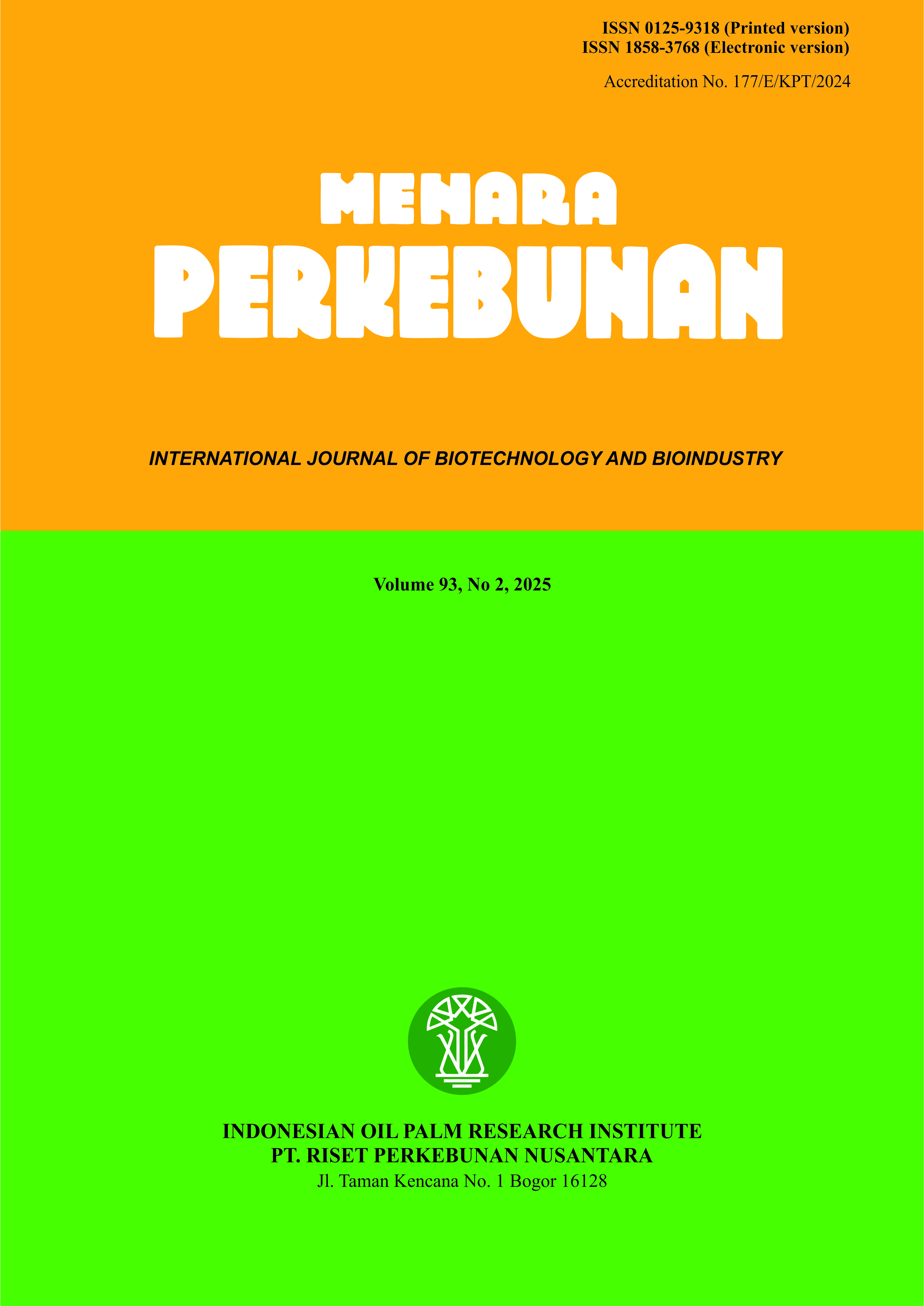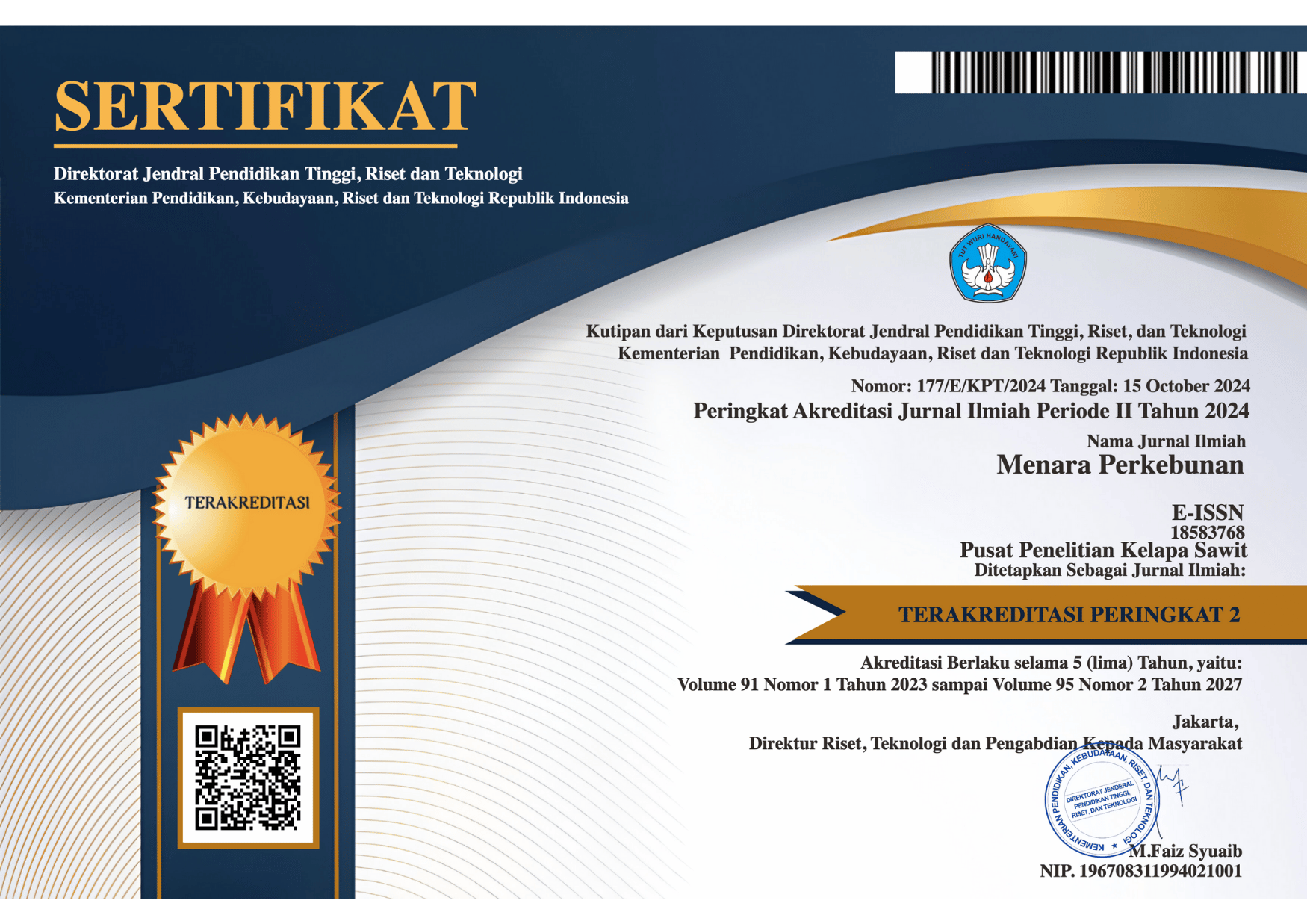Effectiveness of a combination of organosulfur and polyphenols in controlling basal stem rot disease at selected levels of disease severity
DOI:
https://doi.org/10.22302/iribb.jur.mp.v93i2.639Keywords:
in vitro, in vivo, Ganoderma boninenseAbstract
Basal stem rot (BSR) is a major disease of oil palm. One approach to control the pathogen is by using organic fungicides. This study aims to assess the efficacy of two kinds of fungicides, organosulfur and polyphenol, in suppressing Ganoderma boninense and their impact on seedlings. Poisoned agar media were used in the in vitro assay with organosulfur at concentrations of 0.8% and 0.125%, polyphenol at 1.6% and 0.125%, and two combinations: 0.8% organosulfur + 0.125% polyphenol and 1.6% organosulfur + 0.125% polyphenol (v/v), with a 3-replication test. In vivo trials were conducted on 4-month-old oil palm seedlings inoculated with G. boninense. Two treatments were tested: Combination 1 (0.8% organosulfur + 0.125% polyphenol, v/v) and Combination 2 (1.6% organosulfur + 0.125% polyphenol, v/v). The solution was applied by soil drenching, 200 mL per plant, at the stem base every 14 days, totalling four applications within a 3-month period. The treatments were evaluated under three levels of disease severity: Group 1 (asymptomatic plants with fungal fruiting bodies), Group 2 (leaf necrosis ≤ 50%), and Group 3 (leaf necrosis ≥ 50%). The first result demonstrated a full inhibition of fungal growth in treatments with 1.6% polyphenol and the combination of 1.6% organosulfur + 0.125% polyphenol (v/v). In vivo assay results showed that an increase in resistance (measured by prolonged survival) was observed in Groups 1 and 2. These findings indicate that combining organosulfur and polyphenol fungicides can improve seedling resistance to BSR, particularly at early and moderate disease stages.
Downloads
References
Aala, F., Yusuf, U. K., Nulit, R., & Rezaie, S. (2014). Inhibitory effect of allicin and garlic extracts on the growth of cultured hyphae. Iranian Journal of Basic Medical Sciences, 17(3), 150. https://doi.org/10.22038/ijbms.2014.2399
Agustina, A. N. (2020). Effectiveness of coconut shell liquid smoke (Cocos nucifera) in inhibiting the growth of Ganoderma boninense fungi. Agroprimatech, 3(2), 79–82.
Apriyelita, A. (2023). Antimicrobial and antioxidant activity of several extracts of mistletoe (Scurrula ferruginea (Roxb. Ex Jack) Danser) from jengkol plant [Undergraduate thesis, Andalas University].
Arastehfar, A., Lass-Flörl, C., Garcia-Rubio, R., Daneshnia, F., Ilkit, M., Boekhout, T., Gabaldon, T., & Perlin, D. S. (2020). The quiet and underappreciated rise of drug-resistant invasive fungal pathogens. Journal of Fungi, 6(3), 138. https://doi.org/10.3390/JOF6030138
Azzahra, Z., Chatri, M., Emilda, D., Anhar, A., & Handayani, D. (2024). Literature review: phenols and alkaloids as potent plant-derived compounds against pathogenic growth. Proceedings of SEMNASBIO, 810–818.
BPS - Statistics Indonesia. (2023). Indonesian Oil Palm Statistics 2023. Statistics Indonesia. https://www.bps.go.id
Basuki, Farisi, A. O., Sari, K. V., Mandala, M., Utami, A. R., Ristiyana, S., Destiawan, A. H., Safitri, D. U., Susanto, A. D., Isnanto, A. A. B., & Kessumowati, A. D. (2024). Training on the production of sulfur-based pesticides as a multipurpose solution for farmers in Slateng Village, Ledokombo, Jember. Magister of Science Education Community Service Journal, 7(2), 749–754.
Elfina, Y., Sukendi, Efriyeldi, & Sutikno, A. (2024). In vitro test of Bacillus spp. ability to inhibit Ganoderma boninense Pat., the causal agent of basal stem rot in oil palm. Agricultural Journal, 7(2), 575–590.
El-Gendi, H., Saleh, A. K., Badierah, R., Redwan, E. M., El-Maradny, Y. A., & El-Fakharany, E. M. (2021). A comprehensive insight into fungal enzymes: structure, classification, and their role in mankind’s challenges. Journal of Fungi, 8(1), 23. https://doi.org/10.3390/jof8010023
Ennacerie, F. Z., Filali, F. R., Moukrad, N., & Bouymajane, A. (2019). Polyphenols, antioxidant activity, and antimicrobial mechanism of Dittrichia viscosa extracts. Arabian Journal of Medicinal and Aromatic Plants, 5(3), 90–106. https://doi.org/10.48347/ IMIST.PRSM/AJMAP V5I3.18669
Firhalzar, S. & Wisdawati, E. (2022). Uji antagonis cendawan rhizosfer tanaman sawit dalam mengendalikan patogen ganoderma boninense secara in vitro. Jurnal Agrotan, 8(2), 10–12.
Hafizah, Q., Permatasari, L., & Muchlishah, I. R. N. (2024). Factors influencing the antibacterial activity of mangrove leaves (Rhizophora mucronata) against Staphylococcus aureus. Tambusai Health Journal, 5(2), 3829–3836.
Hamzah, A., Saputra, R., Puspita, F., Nasrul, B., Irfandri, & Depari, N. S. (2021). Ganoderma diversity from smallholder oil palm plantations in peatlands of Kampar District, Indonesia, based on mycelia morphology and somatic incompatibility. Biodiversitas, 22(1), 16–22.
Harefa, T. (2022). Decrease in yield and farmer income due to the intensity of Ganoderma boninense disease in oil palm plantations [Thesis, Universitas Medan Area].
Hasrianda, F. E., & Setiarto, B. H. R. (2022). Genetic engineering potential of garlic to increase bioactive allicin compounds and their functional properties. Pangan, 31(2), 167–190.
Izzati, A. N. Z. M. & Abdullah, F. (2008). Disease suppression in Ganoderma-infected oil palm seedlings treated with Trichoderma harzianum. Plant Protection Science, 44(3), 101–107.
Mendoza, L., Navarro, F., Melo, R., Báez, F., & Cotoras, M. (2019). Characterization of polyphenol profile from grape pomace extracts and their synergistic effects with fungicide against Botrytis cinerea. Journal of the Chilean Chemical Society, 64(4), 4607–4609. https://doi.org/10.4067/S0717-97072019000404 607
Moulia, N. M., Syarief, R., Iriani, S. E., Kusumaningrum, D. H., & Suyatma, E. N. (2018). Antimicrobial properties of garlic extract. Pangan, 27(1), 55–66.
Nurhayati (2013). Soil and development of soil-borne pathogens. Proceedings of the National Seminar of MKTI, Palembang, November 6–8, 2013.
Panggabean, N. A. (2023). Identification of Ganoderma boninense basal stem rot disease severity in oil palm of various ages at BLK LPP Rangkasbitung training plantation [Final Project, LPP Polytechnic Yogyakarta].
Prihatiningsih, N., Djatmiko, A. H., & Erminawati. (2020). Anthracnose disease epidemiological components in chili plants in Baturraden Subdistrict, Banyumas. Agro, 7(2), 203–212.
Purba, N. F. (2024). Study of dark septate endophytic fungal metabolites for controlling basal stem rot in oil palm (Elaeis guineensis Jacq.) [Thesis, IPB University].
Putra, S. A., & Sukohar, A. (2018). The effect of allicin in garlic (Allium sativum L.) on Candida albicans activity as candidiasis therapy. J. Agromedicine, 5(2), 601–605.
Qomariyah, N., Retnani, Y., Jayanegara, A., Wina, E., & Permana, G. I. (2019). Biochar and liquid smoke for improving livestock performance. WARTAZOA, 29(3), 171–182.
Rahmana, A. B., Hayata, & Hartawan, R. (2024). Ganoderma infection intensity in oil palm plantations on mineral and tidal land. Media Pertanian, 9(2), 148–154.
Rahmawati, A. (2023). Genetic diversity of oil palm (Elaeis guineensis Jacq.) varieties. Kridatama Science and Technology, 5(1), 35–40.
Rakib, M. R. M., Bong, C. F. J., Khairulmazmi, A., & Idris, A. S. (2015). Aggressiveness of Ganoderma boninense and G. zonatum isolated from upper and basal stem rot of oil palm (Elaeis guineensis) in Malaysia. Journal of Oil Palm Research, 27(3), 229–240.
Rupaedah, B., Amanda, V. D., Indrayanti, R., Asiani, N., Sukmadi, B., Ali, A., Wahid, A., Firmansyah, T., & Sugianto, M. (2018). Activity of Stenotrophomonas rhizophila and Trichoderma sp. in inhibiting the growth of Ganoderma boninense. Biotechnology and Biosciences of Indonesia, 5(1), 53–63.
Sarilla, N. D. A., Ramadhani, I. F. A., Patandjengi, B., Kuswinanti, T. A. N. & Rosmana, A. (2022). Application of garlic extract to improve the growth and health of pakcoy and lettuce in closed hydroponic systems. Proceedings of PERHORTI National Seminar, 88–94.
Sinaga, A. (2024). Effect of rainfall on the development of basal stem rot (Ganoderma boninense) and oil palm production at PT SOCFINDO Bangun BANDAR estate [Undergraduate thesis, Universitas Medan Area].
Townsend, G.R., & Heuberger, J.V. (1943). Methods for estimating losses caused by diseases in fungicide experiments. Plant Disease Report, 27(17), 340-343
Widiastuti, H., Eris, D. D., & Santoso, D. (2017). Potensi fungisida organik untuk pengendalian Ganoderma pada tanaman kelapa sawit Menara Perkebunan, 84(2), 98-105.
Yulianti, M., Harahap, I. & Elsie. (2021). Potential of endophytic fungi from vetiver roots (Vetiveria zizanioides L.) in inhibiting Ganoderma boninense growth. Proceedings of SainTeKes Seminar, MipaKes UMRI (2).
Yusup, A. C., Eris, D. D., Mulyatni, S. A., Pradana, G. M., Widiastuti, H., & Santoso, D. (2024). Potential of combining garlic and polyphenol extracts as a curative method for controlling Ganoderma boninense. Oil Palm Research Journal, 32(2), 111–128.
Yusup, A. C., Eris, D. D., & Priwiratama, H. (2023). Allicin and polyphenols as potential organic fungicides against leaf spot disease pathogens in oil palm. Warta PPKS, 28(3), 146–153.
Downloads
Submitted
Accepted
Published
How to Cite
Issue
Section
License
Copyright (c) 2025 Deden Dewantara Eris, Ciptadi Achmad Yusup, Abdul Aris, Fransiska Natalia Purba, Faizal Shofwan Kusnendi

This work is licensed under a Creative Commons Attribution 4.0 International License.
Authors retain copyright and grant the journal right of first publication with the work simultaneously licensed under a Creative Commons Attribution License that allows others to share the work with an acknowledgement of the work's authorship and initial publication in this journal.













